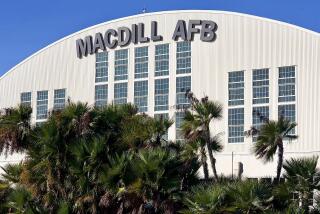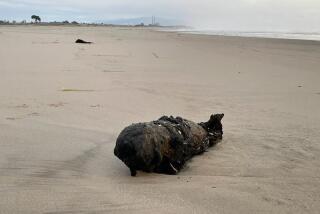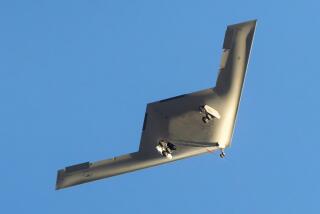Edwards Remembers Its Conquerors of the Sky
EDWARDS AIR FORCE BASE — Pilot Henry “Hap” Arnold had just crossed the Tehachapi Mountains en route to a Riverside airfield in 1928 when his small fighter plane started to shake.
Thinking he might have to crash-land, Arnold, a member of the Army Air Corps, looked down and spied a huge, dry lake bed suitable for landing in the Mojave Desert.
Nonetheless, Arnold continued on to Riverside. “Just like a pilot,” said aviation historian Raymond Puffer. “He thought he could hold the plane together.”
Arnold did--but just barely. He was injured in a rough landing.
Five years later, the pilot remembered the remote lake bed when he needed a training facility for his squadron--and returned to help establish what eventually would be Edwards Air Force Base, one of the most famous airfields in the world.
This week, the sprawling base--home of numerous elevation and speed records achieved by legendary test pilots--is celebrating its 50th anniversary as an Air Force facility.
Military officials also are celebrating the 50th anniversary of the best-known event in the airfield’s history--the first supersonic flight, flown by Charles “Chuck” Yeager just a month after the Air Force took over in 1947.
On Tuesday, Yeager, now 74 and a retired brigadier general, will re-create his historic flight. He will do it again next Saturday and Sunday.
Edwards Air Force base has been an aviation landmark, from its humble origins as the Muroc Bombing and Gunnery Range to its recent designation as the launch site of the X-33--the test model of what NASA hopes will be the space shuttle’s replacement.
“Virtually every military plane has been tested here,” Puffer said. “And you know those astronauts you see in space? Guess where they begin to fly? This is where all the action is.”
It was far from a lively spot at the turn of the century, when the only sign of life was a line of the Southern Pacific Railroad.
In 1910, Clifford and Effie Corum and Clifford’s brother established a 160-acre homestead on the lake’s northeast shore. The Corums built a combination general store and post office, but federal officials denied their request to designate the area as Corum, saying the name was already in use in California. So, the family reversed the letters and called the town Muroc.
Arnold’s troops arrived in 1933, setting up tents that offered little relief from the harsh cold in winter and blistering heat in summer.
“It was a pretty harsh existence,” said Jim Young, Edward’s Flight Test Center chief historian.
Desolation was just what the Army Air Corps was looking for in July 1942, when it sought a site for a top secret aviation project. The top secret project was America’s first jet plane. The Germans and English already had jets and were using them in the early years of World War II, Young said.
On Oct. 1, 1942, with a few personnel gathered for the occasion, test pilot Bob Stanley moved the Bell XP--59A Airacomet onto the hard lake bed.
“We got into it very late and we learned very quickly,” Young said.
But along with triumphs came tragedy. In 1948 alone, the base had 13 flight-related deaths.
Among the casualties was Glen Edwards, a new breed of pilot with advanced aviation degrees who was assigned to the Flying Wing, an experimental aircraft with no tail or fuselage. The Flying Wing was, its designers thought, capable of high speeds. Edwards and his crew crashed during a trial on June 5, 1948. On Dec. 5, 1949, Muroc Air Force Base was renamed Edwards Air Force Base.
This week will be a time of remembering the base’s namesake and others who gave their lives, as well as the successes at Edwards. Aircraft that took off from the base were the first to break the sound barrier, known as Mach 1.
Edwards’ pilots also were the first to hit elevations of 100,000, 200,000 and 300,000 feet in a winged aircraft. And in 1967, pilot Pete Knight--now a state senator from Palmdale--flew a modified X--15 rocket plane at 4,520 mph to establish the winged aircraft speed record.
This week, many notables will be honored.
But Puffer also will be thinking of Hap Arnold, who died in 1950, and the dry lake he saw in 1928.
“He didn’t land there,” Puffer said. “But he remembered the place when he needed it and that’s why we’re here today.”
More to Read
Sign up for Essential California
The most important California stories and recommendations in your inbox every morning.
You may occasionally receive promotional content from the Los Angeles Times.










